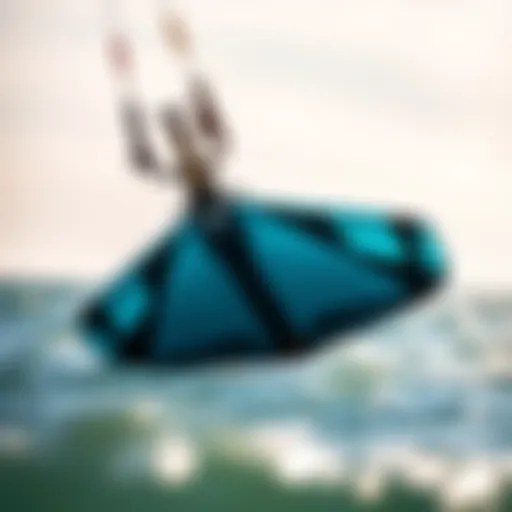The Comprehensive Guide to Waist Leashes in Kiteboarding


Intro
Kiteboarding offers an exhilarating blend of excitement and skill, merging the power of the wind with the artistry of riding the waves. Central to a kiteboarder's safety and performance is a crucial piece of equipment known as the waist leash. This guide takes a deep dive into waist leashes, unraveling their significance, varieties, and the many factors to consider for a safe and enjoyable kiteboarding experience.
The waist leash functions as a critical lifeline between the rider and their board. It not only enhances the control over the equipment but also plays a significant role in safety and convenience. As the sport continues to evolve, so do the designs and functionalities of waist leashes, making it essential for riders across all skills to understand the nuances that come with this gear.
In this guide, you'll discover key information about beginner techniques and advanced maneuvers, as well as insights on maintenance, safety practices, and recommendations on gear. Whether you're a newbie looking to get your bearings or a seasoned rider refining your tricks, mastering the art of selecting and utilizing a waist leash can elevate your kiteboarding adventures.
Techniques
Understanding the techniques associated with waist leashes can significantly impact your riding experience. Learning the right way to use a waist leash not only ensures safety but also helps in mastering your kiteboarding skills effectively.
Beginner Kiteboarding Techniques
For those just starting out, mastering the basics is essential. Begin with the following techniques:
- Proper Attachment: Ensure your waist leash is securely attached to your harness. Many riders make the mistake of loosely connecting it, which can lead to issues later on.
- Controlled Release: Practice releasing the leash in controlled environments. This skill may come in handy during unexpected falls or entanglements.
- Understanding Tension: Learn to recognize the tension in the leash during different maneuvers. This will help in keeping it taut, thus preventing the board from drifting away too far.
As you get comfortable with these basic techniques, you can gradually include more complex maneuvers into your practice. Willingness to adapt and learn from the environment is critical.
Advanced Freestyle Maneuvers
For experienced kiteboarders looking to up their game with freestyle techniques, utilizing a waist leash effectively is paramount. Here are several advanced techniques:
- Kite Loop Tricks: Perfecting kite loops requires a firm understanding of how your waist leash can maintain board control during rotation.
- Handle Passes: This challenging maneuver involves passing the control handle behind your back while executing jumps. Proper leash tension and attachment will help in maintaining stability throughout the move.
- Unhooked Riding: Riding unhooked can be exhilarating but requires strong leash control. Ensuring your waist leash is designed for this method allows for a smooth experience while reducing potential accidents.
With these advanced techniques, you can further enhance your riding style while feeling secure in your movements.
"A hesitate can leave you stretching for control, while a practiced movement saves immense effort and creates fluidity on the water."
Your prowess on the waves is intricately linked to your understanding of your gear, particularly the waist leash. In sum, practice and understanding of these techniques will pave the way for mastery in your kiteboarding journey.
Understanding the Waist Leash
Kiteboarding is not just about harnessing the wind, it's also about mastering the equipment that keeps you safe and enhances your experience on the water. One of the fundamental tools for any kiteboarder is the waist leash. Understanding the waist leash is crucial since it plays a pivotal role in connecting the rider to the kite while allowing for freedom of movement. In this section, we'll dissect what a waist leash is, its purpose, and how it stands apart from other leash types, providing you with the knowledge to make informed choices in your kiteboarding ventures.
Definition and Purpose
A waist leash is essentially a safety device that links the rider to the kite. Instead of being attached to the wrist or ankle, a waist leash is secured around the rider's waist. This setup allows for greater freedom of movement, making it particularly appealing to many kiteboarders. The primary purpose of the waist leash is to maintain the connection with the kite, especially in situations where the kite may be drifting away due to wind shifts or rider fall-offs.
The design prevents the leash from getting caught in the water or on obstacles, which can happen when using other types of leashes. Moreover, it offers a good balance between safety and maneuverability. If a rider loses control, they can simply release the leash without the same level of fuss that can occur with wrist or ankle systems.
To summarize, the waist leash serves two fundamental purposes:
- Connection: Keeps you tethered to the kite, ensuring it won’t wander far if something goes wrong.
- Safety: Allows for quick release in emergencies, enhancing the overall safety net while kiteboarding.
Comparison with Other Leash Types
When you break down the various types of leashes used in kiteboarding, you'll find two common categories: waist leashes and leg (ankle or wrist) leashes. Each has its pros and cons, which can heavily influence a rider’s decision on which to choose.
- Waist Leash:
- Leg Leash:
- Advantages:
- Freedom of Movement: It grants a more natural range of motion compared to leg leashes.
- Easier Retrieval: If you drop the kite, it's easier to reel it back with a waist leash because it’s not dragging in the water.
- Better for Freestyle Maneuvers: Riders who perform flips or tricks often favor this type as it does not hinder their movements.
- Advantages:
- Direct Connectivity: Some riders prefer a leg leash as it connects closer to their body, which can feel more secure.
- Familiarity: These can sometimes be easier for beginners who are already accustomed to other board sports.
However, there's a catch. Leg leashes can become tangled in the water and can pose a risk if they get snagged. For many experienced kiteboarders, the risk/reward ratio leans favorably toward waist leashes, especially for those tackling challenging conditions or advanced maneuvers.
Understanding the differences among leash types not only aids in better equipment selection but also shapes how one experiences the sport. Each rider has unique experiences and preferences that influence their equipment choices, making it essential to explore these elements thoroughly.
The Mechanics of Waist Leashes
The mechanics of waist leashes play a crucial role in the kiteboarding experience, blending practicality with functionality. Understanding how these leashes work not only helps in choosing the right one but also contributes to a better and safer ride. Waist leashes are designed to provide support and control without restricting the rider's movement. This balance is what sets waist leashes apart from other types of leashes in the market.
How Waist Leashes Function
Waist leashes operate on a simple yet intelligent design that attaches securely around the waist, allowing the rider to move freely while being tethered to the kite. One of their primary functionalities is to ensure that if a rider falls, the kite will remain connected without dragging them through the water. The attachment allows for quick release, enabling the rider to disengage from the kite in emergency situations. This effective mechanism allows for semi-autonomous movement, which means the rider can enjoy a more liberated experience without compromising safety.


Moreover, the leash is typically designed with a quick release system that can be activated rapidly. This feature is a lifeline in situations where a rider is overpowered or tangled, allowing them to break free without difficulty.
Material Composition
When it comes to waist leashes, the materials used can significantly impact durability, comfort, and overall performance. Let’s break down the main types of materials commonly employed:
Nylon
Nylon is a staple in the world of kiteboarding leashes, appreciated for its toughness and resilience. One key characteristic is its high tensile strength, which ensures that the leash won’t snap under pressure. This makes nylon an ideal choice for kiteboarding, as it can withstand the rigorous conditions encountered on the water.
The *unique feature* of nylon lies in its ability to resist abrasion, allowing it to perform well against rough surfaces. However, it’s worth noting that over time, exposure to UV rays can weaken nylon, which is a potential disadvantage. Regular inspections for wear and tear are essential to maintain the leash's integrity.
Neoprene
Neoprene contributes to the versatility of waist leashes, thanks to its comfortable fit and flexibility. Known for its lightweight nature, neoprene is not only soft against the skin but also offers water resistance. This material is particularly beneficial for those who engage in long sessions on the water, as it minimizes chafing and discomfort.
A distinctive characteristic of neoprene is its insulating properties, which keep the wearer warm in cooler waters. While neoprene leashes are generally durable, they can be susceptible to tearing if overstressed. Careful handling and proper sizing are critical to prevent potential issues.
Webbing
Webbing, often made from polyester or similar synthetic materials, adds a different dimension to waist leashes. It provides an excellent blend of strength and flexibility, which is vital for kiteboarding applications. The strong nature of webbing helps to distribute forces evenly, reducing the risk of any single point of failure during a ride.
One of the main advantages of webbing is its low profile, which translates to less bulk around the waist. Riders appreciate this minimalistic aspect as it allows for greater maneuverability. However, webbing—while durable—can be prone to fraying under constant wear, making regular checks imperative.
"Choosing the right material for your waist leash is as vital as selecting the right kite for your experience level."
Advantages of Using a Waist Leash
In kiteboarding, having the right equipment can make or break your outing on the water. Waist leashes, in particular, have become a favored choice among many riders due to their numerous advantages. These benefits stretch beyond comfort and delve into freedom, safety, and performance enhancement. Understanding these aspects can really change the way you experience your time spent kiteboarding.
Freedom of Movement
One of the standout features of a waist leash is the unparalleled freedom of movement it offers. Unlike their ankle counterparts, which can sometimes feel restrictive, waist leashes allow for a full range of motion. This is particularly critical when you are performing tricks, navigating through waves, or adjusting your stance while riding. The design typically sits higher around your waist and doesn't hinder leg movement.
A rider with a waist leash can twist and turn without the constant worry of getting tangled or caught up. This freedom is especially beneficial for those who practice freestyle tricks or those who enjoy being more dynamic in their riding style. The reduced drag can make a significant difference, letting riders focus on the wind and their board rather than the leash itself.
"A waist leash isn’t just about holding onto your kite; it’s about unleashing your body’s potential to move."
Another practical aspect here is accessibility. With the waist leash positioned above the waterline, it’s much easier to reach the quick-release mechanism in case of emergencies. This design allows for a smoother transition in various riding conditions and helps maintain your agility on the water.
Enhanced Safety Features
Safety is paramount when it comes to watersports, and waist leashes come with certain enhanced safety features that are worth considering. Their ability to detach quickly in case of an accident is a significant advantage for riders. Unlike other types of leashes that might require more complex maneuvers to release, waist leashes typically come equipped with a quick-release mechanism that can be activated with one swift motion.
This feature is crucial when faced with unexpected situations, such as getting dragged along by the kite or being pulled underwater due to a sudden gust of wind. Rapid detachment can be a life-saver and dramatically reduces the risk of injuries that might arise from being stuck or tangled.
Moreover, waist leashes often incorporate a break-away system that further promotes rider safety. This means that upon excessive tension, the leash will break away, minimizing the risk of entrapment or excessive force being applied to the kite or the rider.
So, investing in a waist leash not only enhances your kiteboarding experience through better movement but also significantly contributes to safer riding practices.
Selecting the Right Waist Leash
When it comes to kiteboarding, selecting the right waist leash is quite a big deal. It’s not just about having any leash but finding the one that suits your riding style, keeps you safe, and feels comfortable for those long sessions on the water. A well-chosen waist leash can elevate your kiteboarding experience, while a poor choice can lead to discomfort or even safety issues.
Factors to Consider
Rider Experience
The factor of rider experience plays a crucial role in selecting the right waist leash. For novice kiteboarders, a durable and easy-to-use leash is recommended. This helps them focus on mastering their skills without getting sidetracked by complications related to equipment. On the other hand, experts might prefer leashes with specific features tailored to advanced maneuvers, increasing their performance on the water.
A popular characteristic among riders is the balance between strength and flexibility. Beginners should look for leashes that won’t easily snap, but also provide some stretch to prevent injury. The unique feature here is the varying thickness of the leash cord; thicker leashes tend to offer higher strength but can limit mobility.
Style of Riding
The choice of leash also heavily depends on the rider's style. Freestyle riders, for instance, usually need a more responsive leash that provides maximum freedom of movement. This type of leash is beneficial since it allows for more dynamic tricks and jumps without hindrance.
In contrast, wave riders might prioritize a leash that offers more durability and less drag in turbulence. Waves can be fierce, and a leash that remains low-profile ensures that the rider stays connected without being overwhelmed by the power of the water.
A unique feature researchers have observed is that varying leash designs may also influence the rider’s ability to execute specific styles. For instance, softer leashes with stretch might help with flexibility during tricks, while stiffer leashes can provide the control needed in powerful waves.
Weather Conditions


Weather conditions should also be factored in when selecting your waist leash. Wind conditions can drastically affect how a leash behaves. In lighter winds, a lightweight leash might be sufficient, while in stronger winds, a more robust leash that can withstand the added stress is necessary.
Additionally, choppy waters can call for leashes with better tug resistance, designed to avoid disconnection during tumultuous rides. The key characteristic of weather-focused leashes is their adaptability to different climates, which is vital for any serious kiteboarder.
One unique feature to note is the compatibility with various environmental factors. For instance, saltwater often leads to quicker wear and tear on equipment, so considering a leash that’s resistant to corrosion is essential when kiteboarding in tropical locations.
Brand Comparisons
With various brands on the market, comparing them is key. Each brand provides different features and caters to varied preferences.
Some renowned brands such as Naish Kiteboarding and Slingshot offer leashes that combine material strength with comfort.
Evaluating customer feedback and expert reviews can help in identifying which brands excel in certain aspects.
"The right waist leash can make or break your session; don’t skimp on quality and fit!"
Ultimately, selecting the right waist leash involves a balanced consideration of rider experience, style of riding, and weather conditions. By weighing these factors against brand comparisons, kiteboarders can find a leash that fits just right for their particular needs.
Maintenance and Care of Waist Leashes
Proper maintenance and care of waist leashes is crucial for not just the longevity of the gear but also for safety while kiteboarding. When the wind kicks up and the ocean's surging, your waist leash acts as the link between you and your kite, making it essential that it functions impeccably. Ignoring maintenance can lead to unexpected failures, which could spoil your day on the water—or worse, result in injury. Regularly looking after this critical piece of equipment ensures a seamless and secure kiteboarding experience, allowing you to focus on having fun rather than worrying about equipment reliability.
Cleaning Guidelines
Keeping your waist leash clean is foundational to its upkeep. After each use, especially in saltwater or sandy environments, rinse your leash with fresh water to remove debris and salt that can cause corrosion and wear over time. Here’s how to effectively clean your waist leash:
- Rinse: Use fresh water to rinse the leash and its components thoroughly, including the leash attachment points.
- Use Mild Soap: If it’s particularly dirty, a mild soap is okay to use. This helps to eliminate grime that rinsing alone may not remove. Avoid strong detergents, as they might damage the materials.
- Dry Properly: After washing, hang the leash to dry in a shaded area. Direct sunlight can break down materials over time, while improper drying could encourage mildew.
- Storage Tips: Store it flat or coiled loosely in a dry place. Hanging can stretch the leash out of shape.
By following these cleaning guidelines, you maintain not only the leash’s function but also its aesthetic appearance.
Inspection for Wear and Tear
Regular inspection is the unsung hero of gear maintenance. Checking for wear and tear on your waist leash should become a part of your routine, especially after intense sessions. Look out for signs that might indicate your leash is nearing the end of its life:
- Frayed Edges: Inspect the leash’s ends and attachment points for any fraying. Even a small amount of fraying can compromise integrity.
- Dirt and Debris Build-up: Sometimes, dirt might accumulate in areas that can’t be rinsed out easily. Ensure there’s no build-up, as that can cause unexpected rigidness or breaking points.
- Broken Components: Look at buckles and attachment loops. If they don’t operate smoothly or show any signs of cracks, it’s time to replace them.
- Material Degradation: Check for stiffness or brittleness in the leash materials. This can indicate UV damage or age-related wear.
Doing these inspections regularly can save you from more extensive problems down the road. And remember, if you’re unsure about the condition of your leash, it’s often best to err on the side of caution and replace it.
"Taking care of your gear is as crucial as your skills on the water. Don’t let a small oversight ruin a perfect ride!"
By understanding the importance of cleaning and inspecting your waist leash, you set yourself up for safer, more enjoyable kiteboarding sessions. Pay attention, and your equipment should reflect your dedication—reliable and ready for whatever the wind may throw at you.
Safety Considerations
The world of kiteboarding is as thrilling as it is challenging, and while waist leashes are indispensable for many riders, safety cannot be taken lightly. Understanding the safety considerations surrounding waist leashes plays a vital role in improving not only your riding experience but also your overall wellbeing on the water. These leashes are designed to enhance freedom and performance, yet they come with their set of risks that every rider should be aware of. In this section, we’ll dive into the potential hazards associated with waist leashes and outline practices to ensure safe and responsible use.
Risks Associated with Waist Leashes
Waist leashes can present certain risks that differ from their counterparts, mainly due to their positioning and the nature of their design. Some common risks include:
- Improper Deployment: If a waist leash is not secured properly, it can malfunction during a fall or a sudden shift in weight, potentially leading to injury or losing control of the kite.
- Entanglement: In some scenarios, the leash can get snagged or wrap around objects, posing a significant risk to the rider. This is particularly concerning in tight spaces or when riding in areas with submerged obstacles.
- Impact and Pressure: Because the waist leash connects at the waist, there’s a chance of impact if a rider falls or is pulled abruptly. This can lead to bruising or more serious injuries if not addressed.
- Increased Resistance: Waist leashes can sometimes lead to increased resistance on a rider’s movements, particularly for those who are new to the sport, dissuading them from performing confidently.
"Awareness and education about these risks isn't just smart—it's essential for every kiteboarder. Ignoring them can lead to dire situations, so let's stay proactive."
Best Practices for Safe Use
Taking proactive steps to mitigate risks associated with waist leashes is crucial for ensuring a safe kiteboarding experience. Here are some best practices you should consider:
- Proper Fitting: Make sure your waist leash fits snugly without being too tight, as this will enhance both comfort and safety during rides.
- Inspect Regularly: Check your leash for signs of wear and tear, including fraying or loose attachments. A well-maintained leash is your best insurance against accidents.
- Stay Aware of Surroundings: Always be conscious of your environment, especially in crowded areas. Look out for other riders, boats, and any potential hazards that could cause you to fall or tangle up.
- Practice Controlled Falls: If you're new to kiteboarding, practice how to fall without panicking. Controlled falls can reduce the risk of injury and keep your leash from malfunctioning.
- Utilize Safety Quick-Releases: Leashes equipped with safety quick-release mechanisms should be your go-to choice. Familiarize yourself with how these work to ensure you can act swiftly if needed.
By grounding your kiteboarding adventures in informed choices and best practice adherence, you equip yourself not only to enhance your skills but also to safeguard your enjoyment on the water.
Keeping these safety considerations on the front burner helps you ride with more confidence and precision, ensuring many enjoyable days ahead in the world of kiteboarding.
Common Misconceptions
In the world of kiteboarding, waist leashes often stir up debates and contradictory views. Misunderstandings can lead to hesitations about using them, which is why it’s crucial to break down these common misconceptions. By addressing what people typically believe and comparing that with the reality, riders can make better-informed decisions that enhance their overall experience on the water.
Challenging Popular Beliefs
A common belief is that waist leashes are only for experienced kiteboarders, but that’s simply not the case. Novices may feel more secure with a waist leash because it allows for greater freedom of movement, giving them more control while they’re learning. Some argue waist leashes are dangerous because they can lead to accidental entrapments. However, when properly managed and used in conjunction with safety measures, this risk is significantly minimized. The right gear and awareness of one’s surroundings play a vital role in ensuring safety while using a waist leash.
Another myth is that waist leashes are uncomfortable or restrictive. In fact, many modern designs incorporate ergonomic features. This means they can fit snugly without pinching or digging into the skin, allowing for comfort during lengthy sessions on the water. More importantly, if you select the right size and adjust properly, the waist leash almost becomes second nature while you ride.


Addressing Rider Concerns
Some riders express concern about whether using a waist leash limits their mobility during tricks or maneuvers. Yet, riders often find that the opposite is true. The flexibility afforded by waist leashes can enhance their performance. It allows for smooth transitions while jumping or aerial tricks. Proper technique ensures that the leash supports dynamic movements.
There might also be worries related to the leash tangling or getting caught in the kite lines. These concerns can overshadow the advantages a waist leash offers. To counter this, riders should ensure they practice safe setups and familiarize themselves with the workings of both the leash and kite. By cleaning and maintaining the leashes regularly and noting the positions of lines, riders can easily navigate around potential snags.
"The real danger lies not in the use of waist leashes, but in lack of knowledge about their proper application and care. Understanding dissolves fear," a seasoned kiteboarder once said.
In summary, clearing the air around these misconceptions is vital for both beginners and seasoned riders. By challenging the beliefs that surround waist leashes and addressing genuine concerns head-on, kiteboarding enthusiasts can embrace a safety-conscious, empowering riding experience. The right attitude and knowledge pave the road to freedom on the water.
Real-World Experiences
The realm of kiteboarding is not just about the gliding through waves and the adrenaline rush that comes with it; it's also deeply rooted in personal experiences that stem from the usage of waist leashes. Understanding these real-world accounts offers an invaluable perspective—one that emphasizes how crucial the right gear can be for both safety and performance. Through firsthand insights, we see how various riders interact with their equipment, shaping their approach to the sport.
Rider Testimonials
Riders from varying backgrounds often have stories that reflect their relationship with waist leashes, and these narratives can illuminate important aspects of their functionality.
For instance, a beginner kiteboarder from Florida recounts how their initial fears were eased by using a waist leash. They share, "At first, I was terrified every time I wiped out, thinking my board would race away like a startled deer. But once I strapped on that waist leash, I felt a level of control I didn't know was possible. Keeping the board close gave me the confidence to push my limits."
This sentiment resonates widely; many riders have found that a well-constructed waist leash not only prevents gear loss but also provides emotional security. Further, an advanced rider highlights their preference for a waist leash during intense conditions. They state, "When it gets rough out there, I trust my waist leash. It allows me to maneuver better without the fear of getting tangled up. My board stays where it needs to be, and I can focus on my technique."
Ultimately, the consensus is clear: rider experiences can reshape preconceptions about waist leashes, showcasing their integral role in both safety and performance.
Expert Opinions
Turning to professional insights, experts in the kiteboarding scene offer a wealth of knowledge regarding waist leashes. Their views typically emphasize the technical evolution and safety potential that these leashes embody.
A notable instructor shared, "Waist leashes might seem like a simple accessory, but they contribute significantly to a rider's agility and control. I always tell my students: a good leash isn’t just about holding you to your board; it’s about enhancing the overall experience. The right leash can make or break your session."
Experts also discuss the importance of adapting gear based on conditions and rider goals. They often recommend variations in materials and designs suited to different riding styles. A renowned kiteboarding coach explains, "For freestyle riders, a stretchy waist leash is often beneficial; it allows for more freedom during aerial maneuvers. On the flip side, wave riders generally seek a stiffer leash to maintain stability in challenging conditions."
"A well-chosen waist leash is more than just a safety strap; it becomes an extension of the rider, allowing for an unmatched connection to the waves."
By examining these real-world experiences, kiteboarders can foster a deeper understanding of how waist leashes can positively impact their adventures on the water.
The Future of Waist Leash Technology
The world of kiteboarding is continuously evolving, and waist leash technology is no exception. As demands grow for better performance and safety in the sport, advancements in materials, design, and functionality play a pivotal role in shaping the future. The importance of this topic lies not just in innovation, but in how these developments can enhance the overall experience for riders. From less bulky models that allow more freedom of movement to smart leashes capable of notifying riders about potential hazards, the next wave of waist leashes will likely rise to match the intensity of modern kiteboarder needs.
Innovations on the Horizon
Expect to see innovations that integrate cutting-edge technology into waist leashes. For instance, some manufacturers are exploring the incorporation of sensors that track rider movements and alert them to any sudden changes that may indicate a loss of control. This feature enables the rider to respond swiftly, minimizing the likelihood of accidents. Additionally, leashes could become more versatile with modular designs that would easily adapt to different riding styles, making them suitable for both freestyle and wave riding.
Riders are also looking for products that seemingly blend seamlessly with gear without compromising comfort or safety. The ongoing improvement in buckle and attachment mechanisms ensures they are intuitive and secure.
A potential development includes leashes that use lightweight yet durable composite materials, which could substantially reduce the weight bearing down on the user while still maintaining strong resistance against pulls from the kite.
Sustainability in Materials
The conversation around sustainability is gaining steady momentum within the sports sector, and kiteboarding isn’t far behind. The future of waist leashes will likely embrace eco-friendly materials. For example, some brands are already experimenting with recycled plastics and organic materials, aiming to produce leashes that are both high-performing and kinder to the planet.
Here’s a quick list of potential elements being discussed in this realm:
- Biodegradable fibers: Leashes that break down more quickly when exposed to natural environments, reducing waste.
- Recycled materials: Using post-consumer plastic for leash production helps minimize the impact on the environment.
- Water-based adhesives: Traditionally, leashes utilized strong chemical adhesives that were harmful. Innovations include using water-based ones, which are less toxic while maintaining durability.
By investing in sustainable practices, kiteboarding brands can not only appeal to environmentally-conscious consumers but also establish themselves as leaders in an industry that respects the world it operates in.
The transition to sustainable materials is no longer a choice but a necessity. Kiteboarders and manufacturers alike must embrace these changes to shape a greener future for the sport.
Epilogue
In this article, we delved into the pivotal role waist leashes play in kiteboarding. A comprehensive understanding of these devices amplifies not just the rider's performance but also their safety on the water. Here’s why the discussion on waist leashes is critical:
- Enhanced Freedom: Waist leashes allow for greater mobility compared to traditional leashes. This feature proves invaluable during maneuvers, enabling riders to focus on their performance without being held back.
- Safety Assurance: With proper use, they significantly reduce the risk of injury, both to the rider and others in their vicinity. A well-chosen waist leash can prevent potential accidents while ensuring a swift response in emergencies.
- Personal Choice: Each rider has unique needs based on their style, experience, and environmental conditions. Understanding these aspects ensures they select a leash that complements their riding habits.
Overall, grasping the importance of waist leashes allows riders to make informed decisions about gear. This knowledge benefits not just individual kiteboarding experiences but also contributes to a safer environment for everyone involved.
Recap of Key Points
- Waist leashes offer greater mobility, which is crucial for performance.
- Safety features are integrated, catering to both rider and bystander protection.
- Selecting the right leash depends on personal factors, aligning with the rider's style and environment.
Encouragement for Further Exploration
Don’t stop here. The world of kiteboarding and its equipment is vast. Explore different brands, read riders' experiences, and perhaps even join forums to engage with the community. Understanding how advanced materials and designs evolve will help you stay current and safe in this exhilarating sport.
Consider experimenting with various waist leashes during your sessions. With kiteboarding, hands-on experience is irreplaceable. The more you know, the closer you get to mastering this incredible sport and enhancing your adventures on the water.







